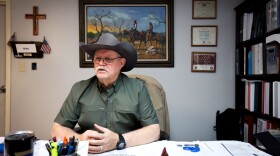Derrick Row was eager to chase cars who fled from him when he first became a Minnesota state trooper — but a pursuit early in his career changed his mindset.
In the early morning hours, Row was chasing a driver on the freeway who fled to avoid a speeding ticket when the driver hit another car. The car that wasn’t involved in the pursuit spun out and the driver, who was 25 weeks pregnant, left in an ambulance.
“That really made me think, there's real risks of doing this and actually hurting someone, so how worth it was it for that one speeder that just didn't want to get a speeding ticket?” Row said.
It has been years since that crash, and Row doesn’t know what happened to the bystander who was taken to the hospital. Today, he said he’s more cautious about pursuits.
Law enforcement across the country get into vehicular pursuits — and they can have deadly consequences. An ongoing investigation by KERA News found rules and accountability for high-speed police chases vary by state. Some, like Texas, leave it up to individual departments. Minnesota has more safeguards in place, including statewide pursuit policy guidelines and continued training and data collection on pursuits, which experts say can make a difference.
Statewide standards
The Minnesota Board of Peace Officer Standards and Training — or POST — maintains a model pursuit policy. It’s meant to be a guideline law enforcement agencies can tailor to their own communities.
Minnesota passed minimum standards for pursuit policies in 1999. The law requires agencies to outline procedures and tactics for pursuits, as well as standards for initiating and terminating chases, and to balance the risks of pursuing with the consequences of not pursuing. Every state and local law enforcement agency must also certify annually that it has a policy in place that meets these minimum standards or they may be sanctioned by the licensing board.
The Minnesota law emphasizes safety. Minnesota State Patrol shares that mission, said Captain Brian Cheney.
"Our goal is obviously to have the safest roads that we can for everybody that uses them,” Cheney said. “So everything we do, including this pursuit policy, has that in mind.”
The guidelines are a collaborative effort, and Minnesota State Patrol and other agencies in the state have a seat at the table, Cheney said.
The current model policy for law enforcement agencies in Minnesota calls for officers to drive with due regard for public safety. It also states only vehicles with emergency lights and sirens can be used for pursuits and it calls for officers to slow down as necessary for safety when approaching a stop sign or red light.
Some agencies in Texas have similar rules in their pursuit policies. The Dallas Police Department’s pursuit policy requires officers to come to a complete stop to ensure an intersection is clear before disregarding a red light or stop sign. And the Fort Worth Police Department’s policy instructs officers to refrain from initiating a pursuit when it would create greater harm to innocent bystanders than warranted.
While Texas requires law enforcement agencies to have a pursuit policy, the state doesn’t have specific guidelines or requirements for that policy. It’s up to individual agencies, and that can lead to vastly different policies at neighboring departments that serve similar communities.
Experts say there isn’t much guidance available for law enforcement agencies to follow when forming their pursuit policies.
"The law on pursuits is really not well formed,” said Howard Williams, a criminal justice professor at Texas State University. “We don't get a lot of instruction from the courts."
The major existing police pursuit laws that apply statewide are the broad guidelines that govern troopers with the Texas Department of Public Safety. They say troopers have a duty to drive safely, may be granted exceptions to traffic laws in emergency situations and can park their vehicles on medians. And the Texas Police Chiefs Association, although not a state agency, has issued guidance on how police should engage in and report chases, including a general model policy . The state’s guidelines on law enforcement’s use of force, which say officers must use the minimum amount of force necessary to make an arrest, also apply to pursuits.

Few state lawmakers in Texas have filed bills to regulate chases. The only bill in the recent regular legislative session that addressed police chases was Senate Bill 3004 from Sen. Cesar Blanco, D-El Paso. The bill focused on border chases, and would have required DPS to adopt a pursuit policy similar to U.S. Customs and Border Protection’s emergency driving and pursuit guidelines from 2023. The bill didn’t make it out of committee.
Some lawmakers who spoke to KERA say there’s been very little discussion about addressing chases. Others say statewide pursuit regulations aren’t necessary in Texas.
"We're right where we need to be,” state Rep. AJ Louderback, R-Victoria, told KERA News earlier this year. “Each chase is a separate entity. Each chase is handled on its own. Each chase the facts are different. There's so many factors here that go into a chase."
There’s also an issue of size. For example, Texas — the second largest U.S. state by area — has more than 2,700 agencies according to the Texas Commission on Law Enforcement.
A true statewide pursuit policy would be difficult for most of the country, said Wendy Hicks, a former criminal justice professor who has done extensive research on police pursuits and use of force.
"Our states are the size of some nations,” Hicks said. “So you can't have one singular policy that's going to be applicable to every location."
And Hicks said other factors that vary by community can contribute to pursuits, including local customs and culture.
That difference in geography and culture is one reason law enforcement agencies have pushed back against statewide pursuit regulations in Texas, state Rep. Ray Lopez, D-San Antonio, told KERA earlier this year.
"A lot of the jurisdictions’ pushback is, 'one size doesn't fit all,'” Lopez said. “And I think that has to be part of the legislation that we craft."
Minnesota’s POST board considers the state’s swaths of rural and urban areas, said Cheney, the Minnesota State Patrol captain. The guideline is a general jumping-off point law enforcement agencies can build on.
“It’s a guideline, right?” Cheney said. “And some of the guiding principles to that guideline are the public safety and traffic safety.”

Enhanced training
The Minnesota law that established the pursuit policy guidelines also has training requirements.
The Minnesota POST Board requires law enforcement agents to perform at least seven hours of classroom and skills based training on emergency vehicle operations and pursuits during its academy course. The POST course curriculum for law enforcement includes several learning objectives on pursuits, including discussion of how pursuit policy impacts police conduct.
The Texas Commission on Law Enforcement —or TCOLE, which is responsible for peace officer licenses — requires a minimum 32 hours of training on emergency vehicle operations in its law enforcement academy course. There’s no training requirements specifically on pursuits.
That means it’s up to individual departments to train their officers on their department’s pursuit policy. Texas requires law enforcement to complete 20 hours of additional training every year after they’ve become a licensed peace officer. But none of those hours are on driving.
Minnesota law enforcement agencies have to send their officers for at least eight hours of additional training on pursuits every five years under state law. Scott Steffen, a driving instructor at Dakota Technical College in St. Paul, said the class is a good refresher.
"The state invested in the police officers, and they wanted to make sure that your training is up to par, up to speed, shall we say,” he said.
The officers in Steffen’s course have a wide range of experience. Officers with more than a decade experience sit in the same classroom as those who’ve been with their department for a month.
Hicks, the former criminal justice professor, said members of law enforcement have a duty to stay up to date on their knowledge and skills to better serve the public. For example, Hicks is also a psychologist and had additional education requirements to maintain her license.
“Doctors do too, lawyers do too, and we certainly do not have the legal authority to kill,” Hicks said. “Anybody who has that authority should definitely need to buck up on the latest developments within their field.”

Tracking the numbers
In addition to the statewide pursuit policy and extra training, Minnesota law requires agencies to report pursuit data to the state’s commissioner of public safety within 30 days.
Experts say keeping track of pursuit data can help departments find problem areas in their policies or training needs. But unlike Minnesota, Texas has no statewide system to keep track of pursuits. That falls to local police departments, each with their own method for authorizing, categorizing and tracking pursuits.
Minnesota is one of six states that maintains a version of a statewide database on chases. The information goes through the agency’s Supplemental Reporting System and is published in the Minnesota Crime Data Explorer.
The Minnesota Crime Data Explorer shows a consistent downward trend for law enforcement pursuits in the state. Law enforcement was involved in 3,522 pursuits in 2021 compared to 2,314 agency involved pursuits in 2024 and 1,522 as of September 2025.
Crashes are also down – 2021 had 285 chases end in an unintentional crash. In 2024, there were 160 pursuits that ended in a crash and 126 crashes as of September 2025.
Fewer pursuits hasn’t led to an increase in crime in Minnesota — the state’s crime rates from 2021 to 2024 are also on mostly downward trend, according to data from the Minnesota Crime Data Explorer.
The most common reason for terminating a pursuit in Minnesota was officer discretion. Cheney, the Minnesota State Patrol Captain, said that shows the consistent training on pursuits works.
“We have seen in the last few years a significant increase in the officer discretion, so it's the troopers themselves, which tells me that our decision making training and our constant conversations about it are working because, the trooper is now recognizing the risk versus the reward,” he said.
The policy standards, data collection and enhanced training in Minnesota serve a purpose — enhancing safety in police chases.
Still, Cheney said no pursuit is without risk.
“The person fleeing is at risk,” he said. “The general public's at risk. The trooper's at risk. We can't obviously control what that other driver's gonna do. We can try to control how we respond and what we do."
Got a tip? Email Caroline Love at clove@kera.org.
KERA News is made possible through the generosity of our members. If you find this reporting valuable, consider making a tax-deductible gift today. Thank you.









